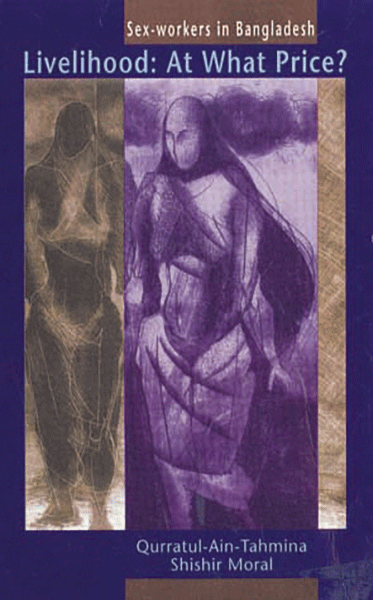By Qurratul-Ain-Tahmina and Shishir Moral
Published by Society for Environment and Human Development (SEHD)
Published 2004, English, PBK, 276 page, Tk.300/US$15
Published 2000, Bangla, PBK, 213 page, Tk.200/US$10
 Sex work remains to be a disgraceful choice in our society and women engaged in this work are defined by abusive terms, all meaning that a sex worker is a “fallen woman”. Different sources estimate the sex-workers in Bangladesh at about 60,000 (as of 2004). They work in brothels, hotels and on the streets. However, these numbers exclude those who work in the residential areas and are better off. Children constitute a significant percentage of the sex-workers. The organized sex trade gangs, poverty, oppression by husband and other family members, temptation for jobs, etc. compel most of the sex-workers into this profession.
Sex work remains to be a disgraceful choice in our society and women engaged in this work are defined by abusive terms, all meaning that a sex worker is a “fallen woman”. Different sources estimate the sex-workers in Bangladesh at about 60,000 (as of 2004). They work in brothels, hotels and on the streets. However, these numbers exclude those who work in the residential areas and are better off. Children constitute a significant percentage of the sex-workers. The organized sex trade gangs, poverty, oppression by husband and other family members, temptation for jobs, etc. compel most of the sex-workers into this profession.
Reliable sources of information and analysis on sex-workers are not many in Bangladesh. In this information void one will find the book, SEX-WORKERS IN BANGLADESH: LIVELIHOOD: AT WHAT PRICE?, authored by Qurratul-Ain-Tahmina and Shishir Moral, useful for information and analysis. In their journalistic exploration they have looked into the issues concerning sex workers with great aptitude and sympathy.
Engaged by the Society for Environment and Human Development (SEHD) they have been investigating the situation of the sex workers since 1999. SEHD published their first work [in Bangla] in 2000. The English edition of the book is a thoroughly updated version of the Bangla edition. In the book the writers cover the majority of the sex workers who are poor.
The authors have explored various aspects and issues of sex work in Bangladesh. One very sad aspect is the agony of the sex workers who are socially excluded and subjected to extreme violence, exploitation and deprivation. The book exposes well the debate and the legality of the sex-work.
One extreme form of inhuman treatment shown to the sex workers is their eviction in violation of laws and court orders. Political forces and state agencies combined are often responsible for this unlawful action. The politics and economics of eviction of three major brothels of the country are also well-explained in the book.
A unique feature of the book is its journalistic style. The information and life stories that are contained in it are carefully organized. The book is handy and a very important resource for anyone interested in sex-work and sex-workers in Bangladesh.
